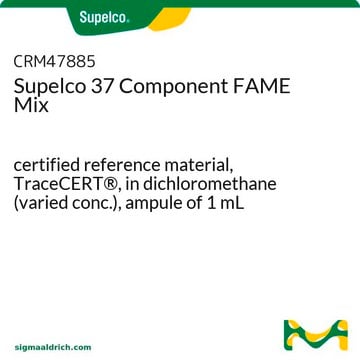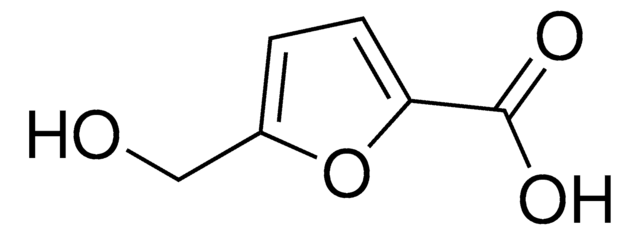If this product has an expiration or retest date, it will be shown on the Certificate of Analysis (COA, CofA). If there is no retest or expiration date listed on the product's COA, we do not have suitable stability data to determine a shelf life. For these products, the only date on the COA will be the release date; a retest, expiration, or use-by-date will not be displayed.
For all products, we recommend handling per defined conditions as printed in our product literature and website product descriptions. We recommend that products should be routinely inspected by customers to ensure they perform as expected.
For products without retest or expiration dates, our standard warranty of 1 year from the date of shipment is applicable.
For more information, please refer to the Product Dating Information document: https://www.sigmaaldrich.com/deepweb/assets/sigmaaldrich/marketing/global/documents/449/386/product-dating-information-mk.pdf
53407
5-(Hydroxymethyl)furfural
analytical standard
Synonym(s):
5-Hydroxymethyl-2-furaldehyde, 5-(Hydroxymethyl)furfural, 5-Hydroxymethyl-2-furancarboxaldehyde, HMF
About This Item
Recommended Products
grade
analytical standard
Quality Level
Assay
≥98.0% (GC/HPLC)
shelf life
limited shelf life, expiry date on the label
technique(s)
HPLC: suitable
gas chromatography (GC): suitable
refractive index
n20/D 1.562 (lit.)
bp
114-116 °C/1 mmHg (lit.)
mp
28-34 °C (lit.)
28-34 °C (lit.)
density
1.243 g/mL at 25 °C (lit.)
application(s)
cleaning products
cosmetics
flavors and fragrances
food and beverages
personal care
format
neat
storage temp.
2-8°C
SMILES string
[H]C(=O)c1ccc(CO)o1
InChI
1S/C6H6O3/c7-3-5-1-2-6(4-8)9-5/h1-3,8H,4H2
InChI key
NOEGNKMFWQHSLB-UHFFFAOYSA-N
Looking for similar products? Visit Product Comparison Guide
General description
Application
Packaging
Signal Word
Warning
Hazard Statements
Precautionary Statements
Hazard Classifications
Eye Irrit. 2 - Skin Irrit. 2
Storage Class Code
11 - Combustible Solids
WGK
WGK 2
Flash Point(F)
174.2 °F - closed cup
Flash Point(C)
79 °C - closed cup
Choose from one of the most recent versions:
Already Own This Product?
Find documentation for the products that you have recently purchased in the Document Library.
Customers Also Viewed
Articles
HPLC-UV determination of 5-HMF (5-(hydroxymethyl)furfural) in beer samples using monolithic silica Chromolith® HighResolution RP-18e HPLC column.
HPLC-UV determination of 5-HMF (5-(hydroxymethyl)furfural) in beer samples using monolithic silica Chromolith® HighResolution RP-18e HPLC column.
HPLC-UV determination of 5-HMF (5-(hydroxymethyl)furfural) in beer samples using monolithic silica Chromolith® HighResolution RP-18e HPLC column.
HPLC-UV determination of 5-HMF (5-(hydroxymethyl)furfural) in beer samples using monolithic silica Chromolith® HighResolution RP-18e HPLC column.
-
How can I determine the shelf life / expiration / retest date of this product?
1 answer-
Helpful?
-
-
How is shipping temperature determined? And how is it related to the product storage temperature?
1 answer-
Products may be shipped at a different temperature than the recommended long-term storage temperature. If the product quality is sensitive to short-term exposure to conditions other than the recommended long-term storage, it will be shipped on wet or dry-ice. If the product quality is NOT affected by short-term exposure to conditions other than the recommended long-term storage, it will be shipped at ambient temperature. As shipping routes are configured for minimum transit times, shipping at ambient temperature helps control shipping costs for our customers. For more information, please refer to the Storage and Transport Conditions document: https://www.sigmaaldrich.com/deepweb/assets/sigmaaldrich/marketing/global/documents/316/622/storage-transport-conditions-mk.pdf
Helpful?
-
Active Filters
Our team of scientists has experience in all areas of research including Life Science, Material Science, Chemical Synthesis, Chromatography, Analytical and many others.
Contact Technical Service











